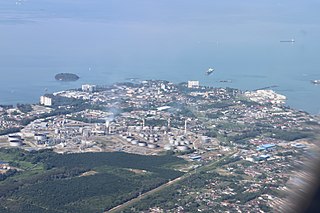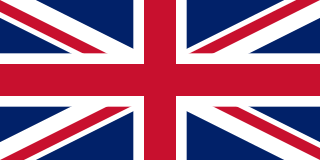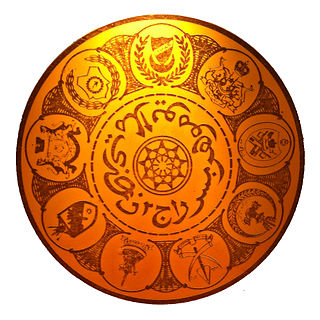
Negeri Sembilan, historically spelled as Negri Sembilan, is a state in Malaysia which lies on the western coast of Peninsular Malaysia. It borders Selangor on the north, Pahang in the east, and Malacca and Johor to the south.

The Undang Yang Empat are the ruling chiefs or territorial chiefs who play an important role in the election of a new Yang di-Pertuan Besar of Negeri Sembilan, Malaysia. The name is believed to be derived from the Malay word undang-undang meaning "law".

The Jelebu District is the second largest district in Negeri Sembilan, Malaysia after Jempol, with a population over 40,000. Jelebu borders on the Seremban District to its west and Kuala Pilah District to its south, Jempol District to its southeast, Bentong and Bera Districts, Pahang to its east and Hulu Langat District, Selangor to the north. Jelebu is a suburban district with blossoming semi-agricultural industry. Jelebu is also a parliamentary constituency of the Dewan Rakyat in the Malaysian Parliament. Kuala Klawang is the principal town of the district.

Port Dickson, colloquially referred to as PD is a beach resort in Port Dickson District, Negeri Sembilan, Malaysia. It is the second largest urban area in Negeri Sembilan after Seremban, its state capital. The town's administration is run by the Port Dickson Municipal Council, formerly known as the Port Dickson Sanitary Board from 29 March 1928 until 28 February 1950, Port Dickson Town Board from 1 March 1950 until 30 November 1979, Port Dickson District Council from 1 December 1979 until 1 February 2002.

Gangga Negara was a semi-legendary Malay-Hindu kingdom mentioned in the Malay Annals. Researchers believe that the kingdom was centred at Beruas and it collapsed after an attack by King Rajendra Chola I of Tamilakam, between 1025 and 1026. According to another Malay annals, the Hikayat Merong Mahawangsa known as the Kedah Annals, Gangga Negara may have been founded by Merong Mahawangsa's son Raja Ganji Sarjuna of Kedah, allegedly a descendant of Alexander the Great or by the Khmer royalties no later than the 2nd century. Raja Gangga Shah Johan was one of its kings.

The term "British Malaya" loosely describes a set of states on the Malay Peninsula and the island of Singapore that were brought under British hegemony or control between the late 18th and the mid-20th century. Unlike the term "British India", which excludes the Indian princely states, British Malaya is often used to refer to the Federated and the Unfederated Malay States, which were British protectorates with their own local rulers, as well as the Straits Settlements, which were under the sovereignty and direct rule of the British Crown, after a period of control by the East India Company.

Sultan Sir Abdul Samad ibni Almarhum Raja Bendahara Raja Abdullah was the fourth Sultan of Selangor.

Lukut is a suburb located to the northeast of Port Dickson, Negeri Sembilan, Malaysia.

The Yamtuan Besar, also known officially as Yang di-Pertuan Besar and unofficially as Grand Ruler, is the royal title of the ruler of the Malaysian state of Negeri Sembilan. The Grand Ruler of Negeri Sembilan is elected by a council of ruling chiefs in the state, or the Undangs. This royal practice has been followed since 1773. The Yamtuan Besar is elected from among the four leading princes of Negeri Sembilan ; the Undangs themselves cannot stand for election and their choice of a ruler is limited to a male Muslim who is Malay and also a "lawfully begotten descendant of Raja Radin ibni Raja Lenggang", the 4th Yamtuan.
This article lists important figures and events in Malayan public affairs during the year 1954, as well as births and deaths of significant Malayans.

The Linggi River is a river in Malaysia which flows through the states of Negeri Sembilan and Malacca. It is one of two major rivers that serve as water sources for most of Negeri Sembilan's population, the other being the Muar River, which constitutes the state's eastern half.
Yeow Chai Thiam was a Malaysian politician and medical doctor. He was a Malaysian Federal Senator for one term, gaining an appointment in 2009. He was a member of the Conservative Malaysian Chinese Association (MCA) and the former MCA Chairman for the state of Negeri Sembilan, the MCA is part of the Federal ruling Barisan Nasional (BN) coalition which has been Malaysia's ruling political party since independence in 1963. Yeow served as the Assemblyman for Jimah and Lukut in the Negeri Sembilan State Legislative Assembly for 20 years and was the State EXCO for Utilities and Local Government for two terms.

The monarchies of Malaysia exist in each of the nine Malay states under the constitutional monarchy system as practised in Malaysia. The political system of Malaysia is based on the Westminster parliamentary system in combination with features of a federation.
Negeri Sembilan Malay is an Austronesian language spoken mainly in the Malaysian state of Negeri Sembilan, including Alor Gajah and parts of Jasin District in northern Malacca, and parts of Segamat District in the northernmost part of Johor. The language is spoken by the descendants of Minangkabau settlers from Sumatra, who have migrated to Negeri Sembilan since as early as the 14th century. It is often considered a variant or dialect of the Minangkabau language; lexical and phonological studies, however, indicate that it is more closely related to Standard Malay than it is to Minangkabau.

Seremban is a city in the Seremban District and the capital of the state of Negeri Sembilan in Peninsular Malaysia. The city's administration is run by the Seremban City Council. Seremban gained its city status on 20 January 2020.

Taman Bunga Merdeka originally known as the Coronation Park is a public park in Malacca City, Malacca, Malaysia. Located along Jalan Kota and facing the People's Museum and other museums, it is one of few parks in the city center. It was built by the British in 1953 and named to memorialise the coronation of Queen Elizabeth II, when the park still fronted on the sea. The park is part of a UNESCO World Heritage-recognized historic district, the Historic Cities of the Straits of Malacca listing.

The Customs Museum is a museum in Kuala Klawang, Jelebu District, Negeri Sembilan, Malaysia, which exhibits facets and lifestyle of the Malaysian people and identity of Negeri Sembilan. It was constructed in 2005 and officially opened on 2 February 2008 by Negeri Sembilan Chief Minister Mohamad Hasan and Minister for Culture, Arts and Heritage Rais Yatim. The museum is housed in a four-story building, with a giant replica of Malay headdress at the top of its entrance and consists of four galleries which are: Introduction of custom, Life cycle, Intellectual tradition, government and power and Pepatih customs.

Port Dickson District is a district in Negeri Sembilan, Malaysia. It is the only coastal district in Negeri Sembilan. The district borders Sepang District, Selangor to the north, the Strait of Malacca to the west, Seremban District to the northeast, Rembau District to the east, and Alor Gajah District, Malacca to the south. It also surrounds Tanjung Tuan, an exclave of Malacca under the jurisdiction of Alor Gajah District, to its southwest.

The Rembau District is a district that is located in the state of Negeri Sembilan, Malaysia. The district is a stronghold of the matrilineal system known as adat perpatih, a customary practice inherited from the Minangkabaus, of Sumatra. The district borders Seremban District to the north, Port Dickson District to the west, Tampin District to the east, Kuala Pilah District to the northeast and Alor Gajah District, Malacca to the southwest.

The Malaysia Vision Valley is a development corridor that encompasses the districts of Seremban and Port Dickson in the state of Negeri Sembilan, Malaysia. The corridor was initially established on 21 May 2015, and it forms the southern continuation of the Greater Kuala Lumpur area.



















